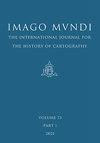印度地图语言实验的语言学概览,1896–1927
IF 0.5
4区 历史学
Q4 GEOGRAPHY
Imago Mundi-The International Journal for the History of Cartography
Pub Date : 2023-08-24
DOI:10.1080/03085694.2023.2225984
引用次数: 0
摘要
本文章由计算机程序翻译,如有差异,请以英文原文为准。
The Linguistic Survey of India’s Experiment in Mapping Languages, 1896–1927
ABSTRACT The Linguistic Survey of India (LSI), supervised by the Anglo-Irish linguist and civil servant George A. Grierson, surveyed and classified more than seven hundred languages and dialects. An integral part of the state-funded survey was mapping where languages were spoken in India, which resulted in the publication of 45 language maps between 1899 and 1927. As individual maps they are comparable to other thematic maps of the period. As a series of language maps, however, they are inconsistent in scale, colour, use of relief and labels, and depiction of boundaries. This paper argues that the inconsistency in presentation reflected the LSI’s experimental approach to mapping language, trying to reconcile the approximate representation of a complex geographical phenomenon with the colonial state’s expectation for accurate and up-to-date language maps.
求助全文
通过发布文献求助,成功后即可免费获取论文全文。
去求助
来源期刊
CiteScore
0.20
自引率
0.00%
发文量
32
期刊介绍:
The English-language, fully-refereed, journal Imago Mundi was founded in 1935 and is the only international, interdisciplinary and scholarly journal solely devoted to the study of early maps in all their aspects. Full-length articles, with abstracts in English, French, German and Spanish, deal with the history and interpretation of non-current maps and mapmaking in any part of the world. Shorter articles communicate significant new findings or new opinions. All articles are fully illustrated. Each volume also contains three reference sections that together provide an up-to-date summary of current developments and make Imago Mundi a vital journal of record as well as information and debate: Book Reviews; an extensive and authoritative Bibliography.

 求助内容:
求助内容: 应助结果提醒方式:
应助结果提醒方式:


